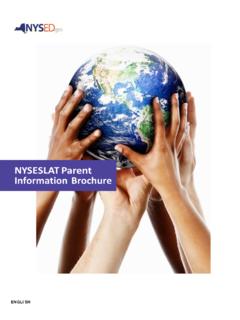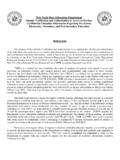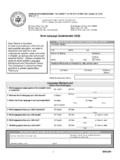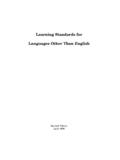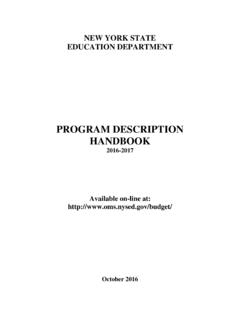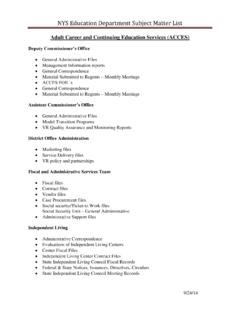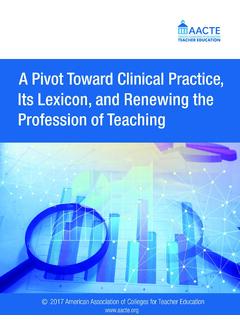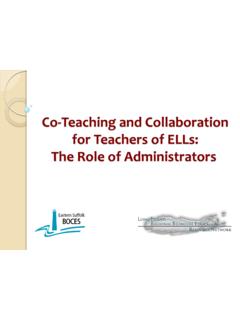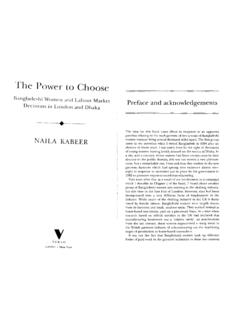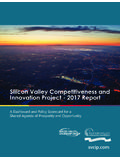Transcription of Advanced Literacies For Academic Success - New …
1 LINGUISTICALLY DIVERSE LEARNERS AND THE NYS next generation P-12 LEARNING STANDARDS BRIEF 1 OF 8 Advanced Literacies For Academic Success Produced for the New York State Education Department by Nonie K.
2 Lesaux, PhD & Emily Phillips Galloway, EdD Why is this important? Reading and writing language-based competencies have becomeprerequisites for participation in nearly every aspect of day-to-day, 21st-century life. There was a time when basic literacy skills provided a clearpath forward, when extended reading and writing were the business ofeducation and only necessary for participation in white-collar today, students needs to develop an increasingly complex set ofadvanced literacy skills and competencies in order to access social andeconomic opportunities.
3 Importantly, the press for Advanced Literacies forall does not reflect a decline in the population s literacy rates. Instead it is a recognition that what counts as literate has changed dramatically over thelast few decades . 1 Today s school leaders especially those serving large numbers oflinguistically diverse learners face a new normal that guides theirinstructional work. To be academically and personally successful in today s literacy- and knowledge-based society and economy, each of their studentsneed to develop what we refer to as Advanced Literacies .
4 Advanced Literacies refers to the skills and competencies that enable communication,spoken and written, in increasingly diverse ways and with increasingly What are Advanced Literacies ? Advanced Literacies refers to the skills and competenciesthat enable communication in increasingly diverseways and promotethe understandingand use of text for a variety of purposes. COMMUNICATE UNDERSTAND ACCESS Communicate (orally and inUnderstand and use print for aAccess and participate inwriting) in increasingly diversevariety of purposes. Academic , civic, and professionalways and with increasinglycommunities, where knowledge isdiverse audiences.
5 Shared and generated. 1 Levy, F., & Murnane, R. (2004). The New Division of Labor: How Computers Are Creating the next Job Market. Princeton: Princeton University Press. 1 diverse audiences.
6 Advanced Literacies also promote the understanding and use of text for avariety of purposes. Likewise they make way for participation in Academic , civic, andprofessional communities, where knowledge is shared and generated. Advanced Literacies support each student to: Advanced Literacies reflect and acknowledge the changing educational landscape. It is the case that many schools have been guided by a series of assumptions about the instruction of linguistically-diverse students that no longer hold in today s instructional settings.
7 Shifting our understanding of the instructional landscape begins with understanding a new set of guiding assumptions. Outdated Guiding Assumptions and Principles Students learning Academic English at school represent a small subpopulationof learners. The strengths and needs of English learners and their classmates are distinct and necessarily demanddifferent approaches. The instructional core is preparing themajority of students to engage inadvanced literacy tasks. Those who struggle needsupplementary intervention. 21st Century Realities and Guiding Principles The school-age population is linguisticallydiverse.
8 There are 400+ native languages in , and by 2030, 40% of the school-agepopulation will speak a language other thanEnglish at home. In many classrooms, the literacy strengths andneeds of English Language Learners,Multilingual Learners, and their English-onlypeers are more similar than they are Academic English, oral and written,should be an instructional priority for all. In many settings, the instructional core needs tobe updated to match today s literacy demands. When large numbers of students are struggling,the core should be adjusted as the primary lineof defense and response.
9 What does Advanced literacy instruction look like across the school years? While it may at first seem like Advanced Literacies are most relevant for older learners, this isn t the case. Even our youngest learners need Advanced Literacies these skills and competencies support learning at all grade levels, even as students are acquiring foundational literacy skills (word reading,spelling, basic communication skills). 2 Advanced Literacies IN PRESCHOOL AND EARLY ELEMENTARY SCHOOL SETTINGS Advanced Literacies IN UPPER ELEMENTARY, MIDDLE.
10 AND HIGH SCHOOL SETTINGS 3 How do we foster Advanced Literacies in today s classrooms? Meeting today s demands for what counts as literate requires a new approach to instructionalleadership for school leaders; they must change the way their schools organize for andapproach instruction.


